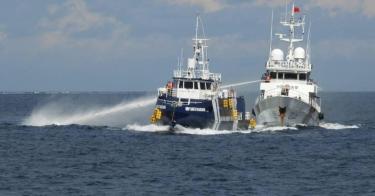This past August, a Chinese Coast Guard cutter and a Navy destroyer collided after harassing a Philippine Coast Guard cutter operating in Philippine waters, resulting in the deaths of some Chinese sailors and severe damage to the ships. The three ships were operating around Scarborough Shoal, which lies within the maritime territory of the Philippines. The Philippine captain maneuvered his vessel so as to prevent it from being damaged (which was the obvious intent of the Chinese vessels).
One silver lining to this incident, at least from a U.S. perspective, is that it demonstrates that the Philippines, despite its limited capabilities, is willing to defend its sovereign territory from outside aggression.
As Philippine President Ferdinand Marcos Jr. stated earlier this year, in the event of a Taiwan war, “there is no way the Philippines can stay out of it.” This is a welcome development for the United States, which believes that Chinese aggression in the Western Pacific is a threat to all Indo-Pacific nations and should be opposed by all.
Indeed, the Philippines, given its geographic location of only 750 miles from Taiwan and 2000 miles from the Chinese mainland, as well as its location adjacent to the South China Sea, could prove a valuable ally in deterring Chinese aggression.
>>> Opposing Taiwan Independence Would Increase Risks of War
The U.S.-Philippine alliance goes back decades. The United States and the Philippines are bound by a mutual defense treaty, first signed by the two countries in 1951. Today, this treaty forms the basis for shared military operations and exercises between the two allies. Balikatan, or shoulder-to-shoulder in Tagalog, is the central annual combined arms exercise conducted in the Philippines with Armed Forces of the Philippines (AFP) and U.S. personnel, in addition to other Pacific allies such as Japan and Australia.
In 2013, the United States negotiated the Enhanced Defense Cooperation Agreement between the two countries. As part of then-President Obama’s “Pivot to Asia,” the agreement allowed for the resumption of U.S. personnel to use, on a rotational basis, former U.S. bases in the Philippines that had been closed at the end of the Cold War. This new agreement, in line with the geopolitical realities of today, has improved bilateral defense ties and expedited any U.S. response to a regional crisis.
Given the ongoing campaign of Chinese coercion, however, the Philippines already needs American support. To provide that support, the United States should deepen its cooperation with the Philippines by providing it with the skills it needs to combat air and maritime threats from China.
To this end, the United States could partner with the Philippines to open a warfare school in Manila to teach Filipino military personnel the operational art of sea and air denial. Called “The School of the Philippines,” such a center might be staffed with about a dozen American military officers serving on a rotational basis, who offer their expertise in anti-access/area denial (A2/AD) warfighting skills to all services of the AFP.
Philippine military personnel would become proficient in employing anti-air capabilities, anti-ship capabilities, anti-drone capabilities, and cutting-edge command and control practices to better defend sovereign Philippine territory on their own. All told, the costs of such a program likely would amount to a few million dollars a year, most of which would be covered by Manila.
Further collaboration in the joint fires and targeting process would greatly benefit the PAF. Such an initiative would enhance A2AD capabilities, in addition to shared readiness and interoperability. For example, exercise Thunderbolt Convergence involved shared weapons systems among NATO allies who conducted a fire mission with the U.S., using their own targeting data. Additionally, there would be an opportunity to introduce and field the Pentagon’s nascent Replicator initiative, aiming to integrate drone swarms with warfighters to counter China’s advantage in “mass” in the Indo Pacific.
Previously, the United States advised the AFP on counterterrorism operations against domestic Islamist insurgents. These operations were relatively successful, and the threat from the insurgents has diminished. With the security environment shifting, Manila has focused its military priorities away from counterinsurgency and counter-terror operations to defending Philippine sovereign territory from external aggression, not least by the writing and implementation of its new national defense strategy: the Comprehensive Archipelagic Defense Concept.
Accordingly, the United States should support that reprioritization by reorienting its advisory capacity from one of assisting in counter-terrorism operations to one in which it can help the Philippines defend itself from an aggressive China. Of course, during joint training at annual exercises U.S. soldiers and marines will continue to benefit by learning lessons from their Philippine counterparts experienced in the jungle warfare employed in this long counterinsurgency campaign.
>>> The Threat of Chinese Investment in the Americas
Effective employment of Short-Range Air Defense (SHORAD) systems and man-portable air defense, such as the Stinger (FIM-92) platform, allows individual soldiers an easy to operate and cost-effective solution to the Chinese air and missile threat. The attendance of Philippine military officers at the 2025 SHORAD Symposium in Pearl Harbor demonstrates Manila’s interest in such capabilities.
Sea platforms are just as critical to national defense. Short range anti-ship missile systems such as the NMESIS and the BrahMos systems are perfect candidates for deterring Chinese maritime aggression.
As a major non-NATO ally of the United States, the Philippines has access certain weapons systems built for the U.S. military. Given the scope of the security challenge posed by China, advancing AFP sophistication in asymmetric warfare should be a priority for the United States, and will bolster the Philippines as a force multiplier in the region.
A School of the Philippines would allow AFP personnel year-long training in the operational art necessary to deter and combat Chinese threats to Philippine sovereignty. Countering Chinese aircraft, drones, and vessels with cost-effective but still highly capable platforms that can deter in peacetime and defeat in the event of war would serve the interests of both Washington and Manila.
This piece originally appeared in RealClear Defense




